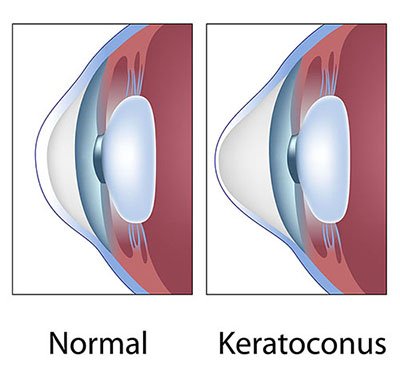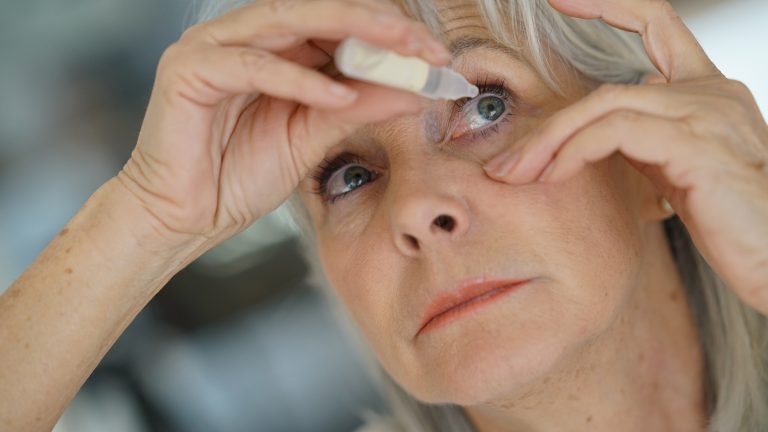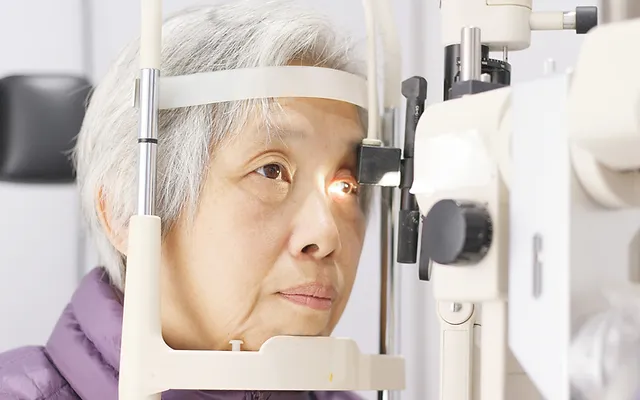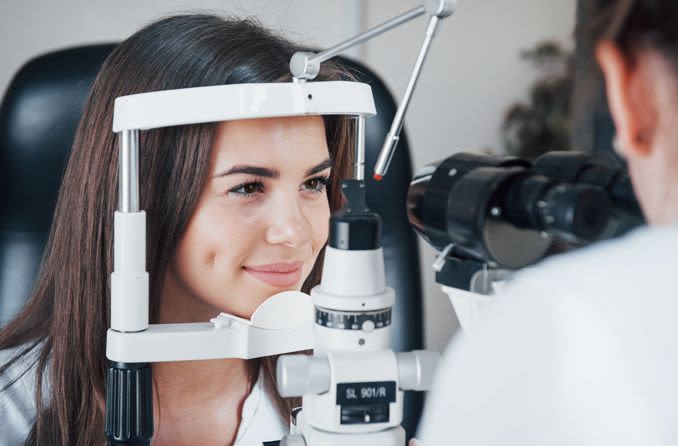What is Corneal Cross-Linking (CXL)?
Corneal cross-linking (CXL) is a treatment for patients with keratoconus or post-LASIK ectasia (bulging of the cornea after LASIK surgery). It is successful in over 90% of cases and can prevent their condition from getting worse. Although approved and used in Europe since 2003, it was not FDA approved in the US until April 2016.
After treatment, you will still need to wear eyeglasses or contact lenses. Your vision might be blurry, and your eyes will be sore for about 1 week after the procedure. Most patients can resume contact lens wear and return to work after one week. As with all procedures, there are risks; CXL is safe, but that is a small chance (less than 2%) of worse vision afterwards.
Keratoconus gets worse because the cornea weakens. CXL uses UV light and vitamin B2 (riboflavin) drops to stiffen the cornea. Used together, they cause fibers within the cornea to cross-link (bond) tighter. This treatment mimics normal age-related stiffening of the cornea known as “natural cross-linking”.
Am I a Candidate?
CXL is for patients who show worsening of their keratoconus or ectasia. Also, for patients who wish to undergo laser eye surgery but are at increased risk for ectasia post-operatively. (For example, those who have very thin corneas, have suspicion for keratoconus, or those who are post-RK surgery). Because of natural cross-linking with age, keratoconus usually stops getting worse by mid-40’s. CXL is not usually required for older patients. Each case is examined on an individual basis.

What is CXL
CXL is the only treatment available to stop the worsening of keratoconus and ectasia. Evidence from many studies one-year post-CXL showed success in halting disease progression. In more than 90% of eyes—with more than 45% of eyes also gaining an improvement in corneal shape. Long-term studies (5+ years) suggest a high success rate in preventing keratoconus progression. Vision is better after CXL in about 50% of eyes treated.
If you need CXL for both eyes, we can offer treatment for both eyes at the same time. CXL is a ‘same-day procedure’. Meaning that you come to the office or surgery center, have the procedure, and go home the same day. There is usually no need for anesthesia or an IV, but if you are nervous, we can give you some medicine by mouth to relax you.
Procedure Overview
The procedure lasts 1-2 hours, depending on the case. Riboflavin eye drops are applied to your eye for about 30 minutes before UV light treatment. Depending on the technique your doctor uses, UV light may then be applied for 15-30 minutes. Anesthetic eye drops are given during the CXL procedure. This way you are comfortable, and a small surgical clip can be placed to keep your eyelids open. The surface layer of your eye (‘epithelium’) is brushed clear before the installation of riboflavin drops. Your doctor will then check your eye(s) to ensure there has been good absorption of riboflavin drops. Following this, UV light is shone at your eye for a predetermined amount of time (15-30 minutes). Then, a soft bandage contact lens (a thinner, larger version of a regular contact lens) is placed on your eye.
After CXL
You will be given eye drops to use after CXL. The soft bandage contact lens will remain in your eye until the surface has healed (about 4-7 days). If the bandage lens falls out during this time, please throw it away—do not attempt to reinsert it.
The anesthetic drops will wear off later after of your procedure. Your eye will become gritty, red, uncomfortable, and sensitive to light for several days. Everyone’s experience of pain is different. Some patients report very little discomfort. Others describe the first few days as very painful. Because your eyes may be sensitive, many patients find sunglasses helpful.
Your vision will be quite blurry at first but will clear over the first few weeks. If you experience increasing pain 3-4 days after the procedure, this could be a sign of infection. You should visit your eye doctor’s office as soon as possible. Please note, the infection rate is rare following CXL, affecting less than 1% of patients.

You should allow at least 4-7 days off work/studies while the surface of your eye heals from CXL. You will be placing eye drops in your eyes at least 4 times per day for the first few weeks. Day-to-day activities, such as watching TV or using a computer will not do any damage to your eye. You may find it more comfortable to rest with your eyes closed early on. A follow up appointment will be scheduled the day after CXL. Afterwards a second follow up usually 5-7 days later to check that your eye is healing properly. Some patients are seen every day post-CXL, to ensure the surface of the eye is healing well.
It is important to put the eye drops in your eye(s) as prescribed. Wash and shower normally but try not to get water in your eye(s). You may exercise 1 week after CXL, but you should not swim, use a hot tub or garden for 7-10 days after CXL.
Your eye doctor will check your vision in the office after CXL to confirm if it is good enough to drive. It is usually safe to resume contact lens wear once the eye surface layer has healed. This is usually the second week after CXL. You should have someone go with you (or have a form of transportation) for the day of CXL as well as all follow-up visits until you have been ‘OK-d’ by your doctor to drive.
Risks of CXL
In general, CXL is very safe. Like all surgeries, your eye needs time to heal, and problems do occur. Approximately 2% of patients will lose some vision in the treated eye because of haze, scarring, and corneal surface shape irregularity. In most cases, this vision loss is reversible with medication or a surgical procedure (laser or corneal transplant). Without CXL treatment, at least 20% of all patients with keratoconus will need a corneal transplant. The risk of transplant for patients with documented disease progression is much higher.
Is Corneal Collagen Cross-Linking Right for you?
Corneal collagen cross-linking is a treatment for keratoconus and other corneal ectasias. Yet not all patients with these conditions qualify for this procedure. Contact SightMD to schedule an appointment with one of our doctors to discuss your vision health at one of our convenient locations to find out if you are a good candidate for Corneal collagen cross-linking!

Recognizing the Signs of a Corneal Ulcer
Understanding Corneal Ulcers Before delving into the signs of a corneal ulcer, let’s briefly review what a corneal ulcer…

Treatment Options for Corneal Infections
What is the treatment for Corneal Infections? The cornea is a transparent, dome-shaped tissue that covers the front of…

Guide to Keratoconus Surgery
A Complete Guide to Keratoconus Surgery Keratoconus is a progressive eye disorder that affects the shape of the cornea,…